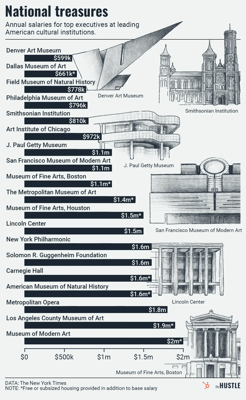Welcome to society’s latest episode of “The Haves and the Have-Nots.” Today, the gulf is rapidly widening between top-tier museums, theater groups, and orchestras and their less-affluent community peers.

- Kicking ass: America’s most influential big-city arts organizations, where top executives are drawing seven-figure salaries.
- Kicking rocks: Smaller museums, nonprofit theater groups, and local orchestras, many of which are facing steep deficits.
Let’s talk about the sad one first
This decade has packed a dangerous cocktail for localized cultural institutions, between a slow pandemic recovery, steep inflation, and labor shortages. Now, many are in peril:
- This summer has seen cost-cutting measures at nonprofit stage companies around the US, per The Hollywood Reporter — from the Oregon Shakespeare Festival to the Brooklyn Academy of Music.
- Some mid-size museums, like Iowa’s National Motorcycle Museum and Virginia’s AAF Tank Museum, are closing their doors for good.
- Labor issues may slow the Philadelphia Orchestra, while others, like the New Jersey Symphony, cut back on staff and programming.
On the other side of the coin…
Though not immune to inflation and post-pandemic visitor slumps, brand-name arts organizations feel the strain without the same sense of immediate danger.
- One thing helping: a greater ability to pass rising costs along to patrons. New York’s Guggenheim Museum raised ticket prices to an all-time high of $30, while the Art Institute of Chicago charges $32 for admission.
Another sign that things aren’t so dire can be found in the corner office — The New York Times identified 29 art bosses, from NYC’s Lincoln Center to LA’s Getty Museum, taking home $500k+ salaries. Those jobs are also often accentuated with housing allowances and first-class travel perks.
Oh, to be a “have”: The director of NYC’s MoMa tops the list with a $2m annual salary — not counting a rent-free apartment above the museum.
